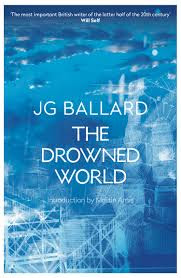
I didn’t like this book at first because it was so dreamlike and weird. Then I started to like it, because it was so dreamlike and weird.
Set in the near future, or what was the near future in the 1960s (which is now, I suppose, the past) it tells the story of a world grown too hot and of all the major cities underwater. It’s a pretty contemporary view of the apocalypse. The story centres on a man called Kerans, who is a scientist conducting tests. Most of humanity is clustered in the Arctic Circle, but he is way south, in England. His team is recalled as the water keeps rising. He refuses to return. Here is where it gets weird. The world is regressing to a past age – the Triassic – with huge plants appearing, alligators everywhere, etc. So human beings are apparently also regressing back to a more primal sort of life form. Kerans, and some of the other scientists, are beginning to lose their humanity, their individuality, and frankly they’re rather liking lettin it go. It’s the joy of the lower life form.
The key delight of this book is this vision of abandoned cities. Here they are in drained London:
They stood in the entrance to one of the huge cinemas, sea urchins and cucumbers flickering faintly across the tiled floor, sand dollars flowering in the former ticket booth. Beatrice gathered her skirt in one hand, and they moved slowly down the line of cinemas, past cafes and amusement arcade, patronised now only by the bivalves and the molluscs
That sort of thing is the heart of the book really. But aware that this doesn’t fill very many pages, Ballard does a reasonable job of knocking together a few other characters and a bit of a plot. A bunch of pirates arrive, and managed to drain the city he is in. Leicester Square appears spookily out of the water, fountains full of weeds. In a half-hearted way Kerans falls in love with strange woman called Beatrice.
While Ballard may be prescient when it comes to rising seawater, he, like other science-fiction writers of the mid-20th century is extremely un-prescient about the rise of women. Beatrice is beautiful and useless, a woman of the 1940s stranded in what’s supposed to be the 21st-century. It’s an odd blindspot across vritually all classic science fiction that I can think of. They can imagine a flying car, a zombie apocalypse, a cyborg nation, but a lady with a mind of her own: let’s not be crazy.
